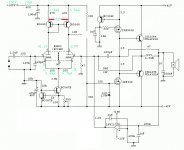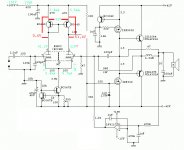update:
kacernator was faster 🙂
It is not tube amp, it's a hybrid Current Dumping amp. Values are matched with rest of the error correction network and desired gain
kacernator was faster 🙂
It is not tube amp, it's a hybrid Current Dumping amp. Values are matched with rest of the error correction network and desired gain
Agree,all hybrits work in the same way,tubes requare thermal to start emmition,during this time amplifier output MUST be connected to nothing.looks like you should get +42 v until tube is heated.
it's a poor design.
high side and low side should both be off if tube is not heated
Your MJE 350 may be bad as it should be off until tube is heated
collector and emitter current should be almost exactly the same
The delay circuit on the protection board keep output disconnected.
Isn't posible to skip a protection board with LARGE delay time.
Here is a well documented Hybrid amp
https://www.hobbielektronika.hu/forum/getfile.php?id=19235
https://www.hobbielektronika.hu/forum/getfile.php?id=19235
Last edited:
Here is a well documented Hybrid amp
https://www.hobbielektronika.hu/forum/getfile.php?id=19235
And sounds much worse than IOTA-CD.
Mugen - no or very low NFB, low damping factor, quasi output.
Well executed current dumping sounds like class A , but without heat, big PSU and thermal compensation needs.
And sounds much worse than IOTA-CD.
Mugen - no or very low NFB, low damping factor, quasi output.
Well executed current dumping sounds like class A , but without heat, big PSU and thermal compensation needs.
I don't know that is not what I read about from DIY-ers.
The DoGC exploded into my face. Only one amp out of more than 100 built or tested.
From a guy who built it some evaluation (translated from Croatian by Google)
After a small problem with the broken water on the plate and the impossibility of setting the quiescent current, I managed to sort everything. Quiescent current set to 150 mA.
Find it hard to like at first describe how to play, but definitely huge potential with neusviranim lamps and relatively low quality coupling capacitors.
Connected to my Onkyo via a variable output, therefore via operational amplifiers, percent Adagio has not arranged until the end ....
Superb dynamics, huge stage, incredibly controlled bass and a bunch of so much detail what I never dreamed to hear from the your system ....
I tried to be objective and forget that I did it myself, but definitely this amplifier plays a miracle. I'll try it agree to end as soon as possible so that Schultz ask for one Slušaona, so that at least one more confirmation of this I'm talking about ....
Last edited:
I don't know that is not what I read about from DIY-ers.
The DoGC exploded into my face. Only one amp out of more than 100 built or tested.
From a guy who built it some evaluation (translated from Croatian by Google)
After a small problem with the broken water on the plate and the impossibility of setting the quiescent current, I managed to sort everything. Quiescent current set to 150 mA.
Find it hard to like at first describe how to play, but definitely huge potential with neusviranim lamps and relatively low quality coupling capacitors.
Connected to my Onkyo via a variable output, therefore via operational amplifiers, percent Adagio has not arranged until the end ....
Superb dynamics, huge stage, incredibly controlled bass and a bunch of so much detail what I never dreamed to hear from the your system ....
I tried to be objective and forget that I did it myself, but definitely this amplifier plays a miracle. I'll try it agree to end as soon as possible so that Schultz ask for one Slušaona, so that at least one more confirmation of this I'm talking about ....
Form a technical point of view, Mugen is just triode differential driving class ab buffer. You get thermal distortion, crossover distortion, low damping factor, relatively high THD because of low NFB.
Current dumping is much better. You dont need thermal compensation - no thermal distortion, crossover distortion is eliminated, output transistor characteristic is irrelevant. Sounds like class A. Infact it is class A stage driving class C stage and class A stage corrects for non-linearities.
I have built all three amps - IOTA-CD, DOGC and Mugen. First two sounds really equally good, sounds like music. Mugen is like ordinary mid-class class ab amp, sounds ok, but nothing exceptional. In the end DOGC wins, because of simplicity over IOTA-CD.
If you want definite answer, then you must built the amps and compare for yourself.
Last edited:
91V between both BC640s' emitters, but nearly the same current flowing through both equal emitter resistors? Can't believe that.
Best regards!
Best regards!
Cant belive that to.
When i unplug tube, on bc640 emiters voltage is still 91V and 0? Only when its tube plug it shows 32V. When desoldered both bc640, on multimeter m328, that works.
Its awsome :/
When i unplug tube, on bc640 emiters voltage is still 91V and 0? Only when its tube plug it shows 32V. When desoldered both bc640, on multimeter m328, that works.
Its awsome :/
Last edited:
Even when i change bc640 with place, the same thing happens, first bc 91V, sec 32V.
Without e88cc voltage ~92V and 0. Voltage on 100ohm resistors, below e88cc similar ~-41V.
I have bulid a couple of amplifiers, but this is WOW, dont understand why.
Without e88cc voltage ~92V and 0. Voltage on 100ohm resistors, below e88cc similar ~-41V.
I have bulid a couple of amplifiers, but this is WOW, dont understand why.
Last edited:
Which PCB did you use?
Remove 1.2k resistor from LF411 output, and 960R resistor from NFB, then measure anode voltage
Remove 1.2k resistor from LF411 output, and 960R resistor from NFB, then measure anode voltage
Pcb was from :::Borina Amaterska Svastara:::
I have not removed 1.2k just unplug opamp, and desolder feedback resistor.
1- 91V and 2- 83V
I have not removed 1.2k just unplug opamp, and desolder feedback resistor.
1- 91V and 2- 83V
PCB was removed from web site. It might be that there was some error on PCB, on DC servo circuit.
OK, this look more normal. Now bring back MJE and 960R resistor. There should be some DC voltage on output, but I do not expect 42V.
OK, this look more normal. Now bring back MJE and 960R resistor. There should be some DC voltage on output, but I do not expect 42V.
the current mirror tries to match the currents in the two halves. To do this well, the two transistors should be operated at the same temperatures, same currents, same voltages. This requires that YOU match the voltages, i.e. Vce for both transistor should be fairly close, not 61Vce for one and 0.6Vce for the other.But look at voltage between collector/emmiter of bc640:
Same for the Long Tail Pair (LTP):
Match the temperatures and currents and voltages in the two halves of the LTP.
I think i know that, but it looks like dc servo destroys this balance 🙂Vce for both transistor should be fairly close, not 61Vce for one and 0.6Vce for the other.
Same for the Long Tail Pair (LTP):
Match the temperatures and currents and voltages in the two halves of the LTP.
Ty enaB i will try to destroy that DC 🙂
Try without it, but this amp requires DC servo to work properly, otherwise there will always be some slowly changing DC voltage on output
- Status
- Not open for further replies.
- Home
- Amplifiers
- Solid State
- 80W Hybrid Audio Amplifier!

